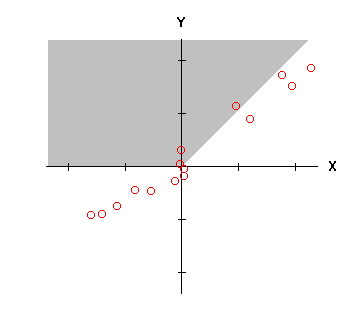
I want to use the same graph from last time to explain the common knowledge that you lose depth when you use more discrimination. These points are all from a single sweep over one target.
This time I have shaded part of the graph to show phase angles that might be discriminated out. Signals that fall in the white part of the graph will be accepted and will begin a beep. Signals that fall in the shaded part of the graph will be discriminated out and will terminate any beep in progress. Using less discrimination means rotating the edge of the shaded area to the left so that more phase angles are accepted. Using more discrimination means rotating the edge of the shaded area towards the right so that more phase angles are rejected.
Using more discrimination does not reduce the strength of the X and Y signals it just changes the decision of which signals will be accepted and which will be ignored. This changes the probability that the signals from a particular target will be accepted.
If all the signals from a target had the same phase angle then you would be able to set the discrimination just barely to the left of the target phase angle, and that target would always be accepted while targets with lower phase angles would always be rejected. But real targets don't act like that. The signal from one target spreads out over a range of phase angles as shown above. And for deeper targets it spreads even more. And if I take multiple swings over the target I will not get the same results each time. If I am not overlapping swings very much and only get a single swing over the target, I might get lower than average phase angles on that swing and not hear the target at all, or it might just sound like trash.
As you increase the discrimination you decrease the probability that all the signals from one target will fall in the accepted range. As some of the signals from the target fall into the rejected area the sound from the detector will start to break up because each rejected signal can interrupt the beep.
Robert Hoolko
